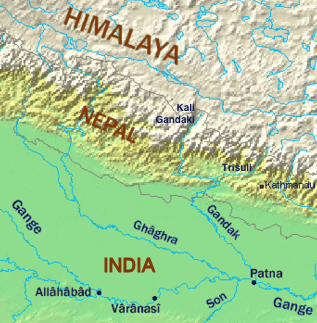
The Ganges or Ganga is a trans-boundary river of Asia which flows through India and Bangladesh. The 2,525 km (1,569 mi) river rises in the western Himalayas in the Indian state of Uttarakhand, and flows south and east through the Gangetic Plain of North India into Bangladesh, where it empties into the Bay of Bengal. It is the third largest river on Earth by discharge.

The Hooghly River or the Bhāgirathi-Hooghly, originally and in local tongues the 'Ganga', and also called Kati-Ganga, is an approximately 260-kilometre-long (160 mi) distributary of the Ganges River in West Bengal, India. The Ganges splits into the Padma and the Ganga near Giria, Murshidabad. Today there is a further man-made bifurcation of the river upstream at Farakka. The Padma flows eastward into Bangladesh, whereas the Ganga flows south through West Bengal. The river flows through the Rarh region, the lower deltaic districts of West Bengal, and eventually into the Bay of Bengal. The upper riparian zone of the river is called Bhagirathi while the lower riparian zone is called Hooghly. Major rivers that drain into the Bhagirathi-Hooghly include Mayurakshi, Jalangi, Ajay, Damodar, Rupnarayan and Haldi rivers other than the Ganges. Kolkata and Hugli-Chinsura, the headquarters of Hooghly (district), are located on the banks of this river.

The Meghna River is one of the major rivers in Bangladesh, one of the three that form the Ganges Delta, the largest delta on earth, which fans out to the Bay of Bengal. A part of the Surma-Meghna River System, Meghna is formed inside Bangladesh in Kishoreganj District above the town of Bhairab Bazar by the joining of the Surma and the Kushiyara, both of which originate in the hilly regions of eastern India as the Barak River. The Meghna meets its major tributary, the Padma, in Chandpur District. Other major tributaries of the Meghna include the Dhaleshwari, the Gumti, and the Feni. The Meghna empties into the Bay of Bengal in Bhola District via four principal mouths, named Tetulia (Ilsha), Shahbazpur, Hatia, and Bamni.

The Padma or Podda is a major river in Bangladesh and India. It is the main distributary of the Ganges, flowing generally southeast for 120 kilometres (75 mi) to its confluence with the Meghna River near the Bay of Bengal. The city of Rajshahi is situated on the banks of the river. However, over 660 square kilometres (256 sq mi) of land, has been lost due to erosion of Padma since 1966.

Bangladesh–India relations, also referred to as Bangladeshi-Indian relations or Indo-Bangladeshi relations, are the bilateral relations between Bangladesh and India, both of which are South Asian neighbours. Diplomatic relations between the two countries formally began in 1971 with India's recognition of an independent Bangladesh.

Geography of West Bengal, a state in eastern India, is diverse, of high peaks of Himalaya in the northern extremes to where Himalayas are in the north and sea is at the south, with both plains and plateaus covering the remaining region.
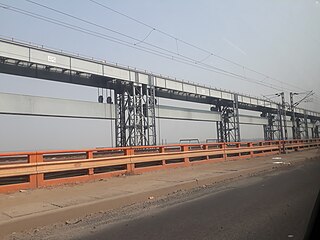
Farakka Barrage is a barrage across the Ganga river located in Murshidabad district in the Indian state of West Bengal, roughly 18 kilometres (11 mi) from the border with Bangladesh near Shibganj. Farakka Barrage Township is located in Farakka in Murshidabad district. Construction of the Farakka barrage started in 1962, was completed in 1970 at a cost of $208 million. Operations began on 21 April 1975. The barrage is about 2,304 metres (7,559 ft) long. The Feeder Canal (Farakka) from the barrage to the Bhagirathi-Hooghly River is about 42 km (26 mi) long. The Ganges river splits into two rivers - Bhagirathi-Hooghly River and Padma River, a little after Farakka Barrage and both flow into the Bay of Bengal.
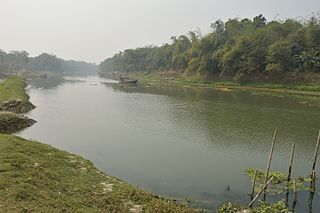
River Churni is a stream in the Nadia district of the Indian state of West Bengal. It is a distributary of the Mathabhanga River, itself a distributary of the Padma River at Munshiganj in the Kushtia District of Bangladesh. The Mathabanga divides into two rivers, the Ichamati and the Churni near Majhdia in Nadia district.
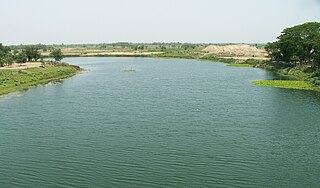
Jalangi River, is a branch of the Ganges river in Murshidabad and Nadia districts in the Indian state of West Bengal. It flows into the Bhagirathi river and strengthens its lower channel, the Hooghly.

Saraswati River refers to a river, that was a distributary of the Bhagirathi and is now no more there but was active till around the 16th century AD. The course and condition of the Saraswati has played an important role in the development and decline of river port towns in Bengal. Initially, the major port town was Tamralipta, after the decline of which Saptagram rose and declined, and finally Kolkata came up.

The India–Bangladesh Treaty of Friendship, Cooperation and Peace was a 25-year treaty that was signed on 19 March 1972 forging close bilateral relations between India and the newly established state of Bangladesh. The treaty was also known as the Indira–Mujib Treaty, after the signatories of the treaty the Prime Minister of India Indira Gandhi and the Prime Minister of Bangladesh Sheikh Mujibur Rahman.

Abdur Razzaq was a Bangladeshi politician and member of the Awami League Advisory Council. He was the Minister for Water Resources from 1996 to 2001 in the first Sheikh Hasina Cabinet. He was the chairman of the Parliamentary Standing Committee for the Water Resources Ministry.

The National Waterway 1 (NW-1) or Ganga-Bhagirathi-Hooghly river system is located in India and runs from Prayagraj in Uttar Pradesh to Haldia in West Bengal via Patna and Bhagalpur in Bihar across the Ganges river. It is 1,620 km (1,010 mi) long, making it the longest waterway in India. It is of prime importance amongst all the national waterways considering its locational advantages. The NW-1 passes through West Bengal, Jharkhand, Bihar and Uttar Pradesh and serves major cities and their industrial hinterlands like;
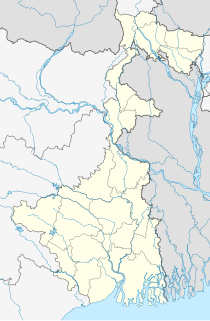
Farakka is a community development block that forms an administrative division in Jangipur subdivision of Murshidabad district in the Indian state of West Bengal.

Azimganj is a railway station on the Barharwa–Azimganj–Katwa loop and is located in Murshidabad district lying west of Bhagirathi, a part of the Hooghly river in the Indian state of West Bengal. It serves Jiaganj Azimganj municipality.
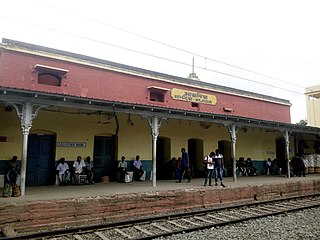
Majhdia, also known as Majdia, is a village in the Krishnaganj CD block in the Krishnanagar Sadar subdivision of the Nadia district, West Bengal, India.

Gede is a village and a border checkpoint in the Krishnaganj CD block in the Krishnanagar Sadar subdivision of the Nadia district in the state of West Bengal, India.

The Ganges Barrage Project was a proposed project in Bangladesh to hold back rain water of the monsoon season because of the periodic drying up of the Ganges River in Bangladesh due to the Farakka Barrage. It was formally cancelled in 2017.

Feeder Canal is a canal associated with Farakka Barrage. It is located in Murshidabad district, West Bengal. The canal is 38.3 km(26 miles) long. The Ganges water from the Farakka Dam is being conveyed to Bhagirathi by way of this canal. Due to the flow of river Bhagirathi-Hooghly through the Farakka dam project, around 40,000 cusec of water is available daily in the Feeder connection. The Feeder canal has been designed keeping in mind the ability to carry this amount of water. However, during the dry season, less water is released. The dry season is from January to May. During the period the flow of water in the feeder canal is reduced from 40 thousand cusecs to 30 to 28 thousand cusecs. If the severe drought brings down the Ganges water from its upper reaches, then less water is available in feeder canal.
River bank erosion along the Ganges in Malda and Murshidabad districts focusses on river bank erosion along the main channel of the Ganges in Malda and Mushidabad districts of West Bengal, India.
